Contents
There are many medicinal and health benefits of cabbage; however, before we get into them, let’s learn a little more about this vital food. Few vegetable species have produced several such varieties, with so many variations among them as the cabbage. For example, who would say the Brussels sprout and red cabbage are the same species? The vegetable kingdom participates in this immense potential for intraspecies variety, as observed in the animal kingdom. Who would say that the Chihuahua belongs to the same species as Saint Bernard?
Despite the variety of colors and shapes of the different cabbages, they all contain the same number of chromosomes in their cells (eighteen), and they reproduce by cross-pollination. In other words, they are one species, as are the different breeds of dogs. All current varieties of cabbage are derived from the wild cabbage still found along the Atlantic coasts of France and England.
The different varieties of cabbage derive from the portion of the plant where its growth energy is concentrated:
- In the leaves: white cabbage, red cabbage, Savoy cabbage
- In the inflorescence: cauliflower, broccoli
- In the base of the stalk: kohlrabi
- In the sprouts: Brussels sprouts
Cabbage was already an essential food in the Greco-Roman period. In addition to enjoying it as food, the Greeks discovered its medicinal properties. Hippocrates, Galen, and Dioscórides praised cabbage’s many health benefits. Cato the Elder, a Roman philosopher of the 2nd century before Christ, declared that “if the Romans had endured the previous six centuries without physicians, it had to be attributed to the use of cabbage.”
Despite this, cabbage has been considered a food for the poor throughout history. This insulting view of cabbages changed dramatically some decades ago when their great anticarcinogenic potential was discovered: cabbage contains substances capable of preventing malignant tumors from forming and even stopping their growth.
In addition to this anticarcinogenic property, cabbages have many other dietary, therapeutic, and medicinal properties, such as those described below.
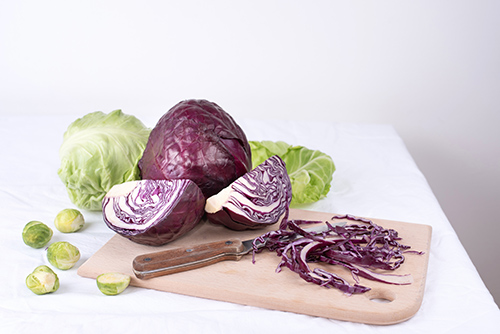
Cabbage Nutritional Facts
Cabbage leaves comprise a vast variety of nutrients:
PROTEINS – A surprisingly good proportion varies between 3.38 percent in Brussels sprouts and 1.39 percent in red cabbage. As with many vegetable proteins, these are incomplete because they do not contain all amino acids. However, combined with other vegetable proteins, such as those in whole grains or legumes, they become high-quality complete proteins.
FATS or LIPIDS are present in marginal, almost nonexistent amounts. Only Brussels sprouts reach 0.3 percent. The remaining varieties vary between 0.1 percent and 0.2 percent of their weight. This lack of fats makes cabbage a very appropriate food for those suffering from coronary disease and obesity. The fats in cabbage, despite their scarcity, are of great preventative and healing importance. Sulfurated substances dissolved in them are responsible for most of the health benefits of cabbage. These are currently being identified as phytochemicals.
CARBOHYDRATES – Most cabbages contain between 3 and 5 percent.
VITAMINS—Cabbages are particularly rich in beta-carotene (provitamin A) and vitamin C, although they contain significant amounts of vitamins B, E, and K. The amount of provitamin A varies greatly among varieties. The greener the leaves, the more it contains.
MINERALS and TRACE ELEMENTS – All cabbages, in general, are rich in potassium and extremely low in sodium. This makes them of excellent value in hypertension or fluid retention cases. They also contain considerable calcium, phosphorus, iron, magnesium, and trace elements, the most notable of which is sulfur. Cabbages are a reliable source of calcium, as much for their quantity (35-77 mg/100 grams, half that of milk), as for the ease with which it is absorbed. Studies have shown that the body digests the calcium in cabbage much better than in milk.
VEGETABLE FIBER—Cabbages are rich in cellulose vegetable fiber. Thus, they are laxatives that help regulate passage through the intestine. Some people who tend to form intestinal gas experience flatulence from eating cabbage.
PHYTOCHEMICALS – These recently discovered substances found in fruits and vegetables in tiny quantities play essential roles within the body. As methods of chemical analysis are perfected, more phytochemicals are being discovered. The plants that make up the Cruciferae family are the most studied in this scientific quest. These unknown elements have aroused great scientific interest, demonstrating that there is still a great deal to be learned about the composition of plant-based foods.
Of the phytochemicals found in cabbage, the most important and most studied effect is that of being anticarcinogenic. However, these surprising substances may have other medicinal effects, such as preventing or treating ulcers or diabetes or have antibiotic properties.
Health Benefits of Cabbage
With such a varied and scientifically intriguing composition, cabbages offer the following medicinal applications:
GASTRODUODENAL ULCER—The healing capacity of applying cabbage leaves to the skin has been known for generations. Doctor Ernst Schieder describes experiments at Stanford University that demonstrated the healing effect of cabbage juice on gastric and duodenal ulcers. The healing time for ulcer patients who drank a glass of fresh cabbage juice (200 to 250 ml) 4 or 5 times daily was shortened to two weeks. Their stomach pain also disappeared within a few days of drinking this juice.
Subsequent experiments have shown that smaller amounts of cabbage juice (from 2 tablespoons to one-half glass) are equally effective. Early investigators attributed cabbage’s effect on ulcers to a little-understood lipid that they referred to as “vitamin U.” Today, it is known that no vitamin is involved. The effect is possibly due to one of the cabbage’s phytochemicals being identified and analyzed.
OTHER STOMACH DISORDERS—After a few days of treatment, a few spoonfuls of cabbage juice taken on an empty stomach five or ten minutes before meals are sufficient to relieve stomach inflammation. The typical symptoms of functional dyspepsia, heaviness, eructation, and stomach pain disappear.
INTESTINAL DISORDERS—Cabbage’s cellulose fiber content has a mild laxative and regulating effect on intestinal transit. It is beneficial in cases of chronic constipation and diverticulosis. The sulphurated substances in cabbage act as antibiotics, helping rebalance the bacterial flora within the intestine in cases of infection. Fresh cabbage juice (half a glass three or four times daily) may complement the treatment of colitis, fermentation, and bacterial imbalance in the intestine.
Experiments using cabbage juice have been conducted with patients with ulcerative colitis, a severe disease of the intestinal mucosa of unknown origin. The juice is given before meals three or four times a day. The healing action of cabbage is expected to have the same effect on intestinal ulcers resulting from colitis.
INTESTINAL PARASITES – Cabbage juice drunk on an empty stomach has also been used as a vermifuge to expel intestinal parasites. One drinks half a glass on an empty stomach each morning for five consecutive days.
CARDIOVASCULAR DISORDERS – Cabbages, in general, are rich in potassium and low in sodium. The latter directly influences the genesis of high blood pressure because of its capacity to retain water and increase blood volume. Cabbage has a mild diuretic effect and is appropriate for those suffering from coronary heart disease, hypertension, and arteriosclerosis (hardening and narrowing of the arteries). Cabbage’s content of antioxidant vitamins (A, C, and E) contributes to the regeneration of arterial walls.
OBESITY – Cabbages provide very few calories (20 to 40 kcal/100 grams, except Brussels sprouts, which may have up to 43 kcal/100 grams). However, they provide a satisfyingly full feeling (relieves the appetite). Because of this and its richness in vitamins and minerals, cabbage is ideal for the obese. It should be included in all weight-loss diets.
OSTEOPOROSIS and DECALCIFICATION – Cabbage’s calcium content is significant (approximately half that of milk). This calcium is also particularly easily absorbed by the body. Consequently, cabbages must be carefully considered in cases of osteoporosis, decalcification, and any circumstance requiring more significant levels of this mineral.
DIABETES—Because cabbage contains few carbohydrates and is rich in vitamins and minerals, it is very well tolerated by people with diabetes. Dr. Schneider explains that the beneficial effect of cabbage in cases of diabetes is due to the impact of substances like insulin, which lowers the blood glucose level.
SCURVY—The vitamin C content of cabbage, like that of oranges (53 mg/100 grams), has given these vegetables a reputation as a remedy for scurvy in Central and Northern European countries. Where, particularly in winter, there may be a shortage of vegetables and fresh fruits (rich in vitamin C), cabbage is one of the best, if not the only, sources of this vitamin.
CANCER – Many animal studies have shown that regular cabbage consumption can prevent the formation of cancers.
Cabbage Prevents Cancer
Many experiments have been conducted with laboratory animals (most commonly rats), demonstrating the anticarcinogenic properties of cabbages and, in general, all the plants of the crucifer family. These studies show that animals fed on cabbage, including those submitted to potent carcinogens such as benzopyrene in tobacco smoke, do not develop tumors.
As these studies continue, the preventative activity of certain substances in cabbage, such as glucobrassicin and breast cancer in women, is becoming known.
The substances in cabbages responsible for their anticarcinogenic effect and the piquant taste of some varieties are sulfurated glucosides (glucosinolates), indoles, and sulfoxides, which are grouped under phytochemicals. Their action is preventative and curative, as has been demonstrated, in inhibiting the growth of certain tumors.
Cabbage and Thyroid
Cabbage contains various glucosinolates responsible for its piquant flavor and anticarcinogenic effect. One of these, formerly called goitrin, also has an undesirable effect: it interferes with the absorption of iodine by the thyroid, stopping the activity of this important gland (antithyroid effect).
This substance is only produced by the action of an enzyme released when raw cabbage is mashed or chewed. Cooked cabbage does not have this effect. It is unlikely that this antithyroid substance, included in cabbages, will create a goiter, even in those who regularly eat it raw. However, raw cabbage should be avoided as a cautionary measure in cases of hypothyroidism or goiter.
Cabbage Scientific Facts
- Scientific name – Brassica oleracea L.
- French – Chou.
- Spanish – Col.
- German – Kohl.
- Description—Cabbages are the leaves of diverse varieties of Brassica oleracea L., a biannual or multi-annual herbaceous plant of the botanical family Cruciferae.
- Environment – The cabbage is originally from the coastal regions of Central and Southern Europe. Its cultivation has stretched to the five continents. It adapts very well to cold climates.
How to use and Prepare Cabbage
- RAW – Fresh leaves, finely shredded and seasoned with oil (preferably olive oil) and lemon, make an excellent salad.
- FRESH JUICE – This is prepared in the blender. Two to three spoonfuls to half a glass on an empty stomach before each meal three or four times a day.
- COOKED – Cabbage should be cooked carefully to protect its medicinal properties. Sulfurous phytochemicals are heat-sensitive and disappear with prolonged cooking. The optimal cooking method is steaming.
The Cabbage Family
All cabbages belong to the botanical family Cruciferae, and most are varieties of the same species: ‘Brassica oleracea.’ There are more than one hundred types of cabbages, only the best known of which are described here.
COLLARD
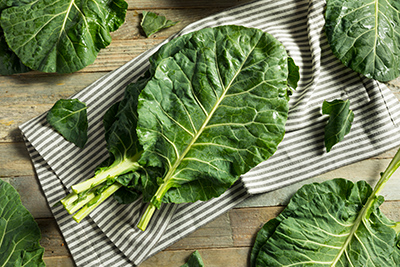
Brassica oleracea L. var. acephala.
French: Chou [commun].
Spanish: Col común, berza.
German: Grünkhol.
This variety of cabbage is among the richest in nutritional elements. Particularly noteworthy are its beta-carotene (provitamin A), vitamin C, and the minerals potassium, calcium, and manganese. It is rich in chlorophyll and vegetable fiber. Its flavor is more robust than that of other cabbages. Due to its high cellulose content, its leaves are tough and unsuitable for eating raw. It is best eaten boiled, steamed, or roasted.
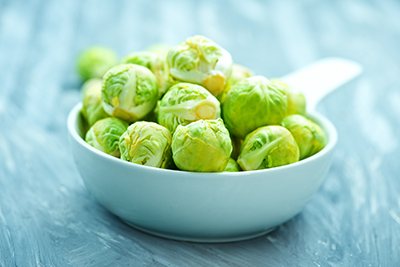
BRUSSELS SPROUT
Brassica oleracea L. var. gemmifera
French: Chou de Bruxelles
Spanish: Col de Bruselas
German: Rosenkohl
These were first grown near Brussels, Belgium, over a century ago. They are raised in the Netherlands, France, Great Britain, and many other countries today. Brussels sprouts resemble small cabbage heads that grow along the plant’s stalk. They are round, with a diameter of 3 to 5 cm. Gastronomically, they are the most valued variety of cabbage because of their intense, unique flavor. Brussels sprouts are rich in vitamins (particularly A and C) and minerals (predominantly potassium, calcium, iron, and sulfur). They are noteworthy among cabbages as the variety with the highest percentage of carbohydrates and proteins.
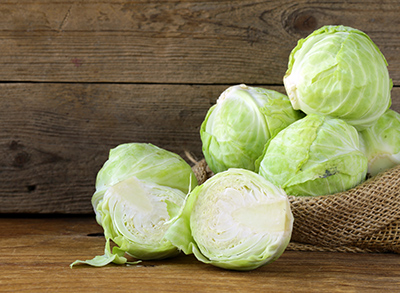
WHITE CABBAGE
Brassica oleracea L. var. capitata ssp. Alba
French: Chou pommé
Spanish: Col blanca, repollo [blacno]
German: Weißkohl.
This is the most familiar variety of cabbage in Central European countries, where it is highly valued for making sauerkraut (fermented cabbage). Germany is one of the primary producing countries. The smooth, light-green leaves of the early varieties are delicious. It is ideal for making cabbage rolls, for all types of cooking, and to be consumed raw when shredded.

CHINESE CABBAGE
Brassica pekinensis (Lour.) Rupr.
French: Chou chinois.
Spanish: Col china, repollo de china
German: Chinakohl
Although it is originally from China, its cultivation is becoming more widespread in Europe. Its leaves are like those of lettuce or chard. You can consume them raw in salads when they are young and tender. When cooked, they have a more delicate flavor than other cabbages. Its nutrition is deficient in carbohydrates, fats, and proteins, resulting in calories (16 kcal/100 grams). On the other hand, it contains a great deal of beta-carotene (provitamin A) and a significant amount of vitamin C.
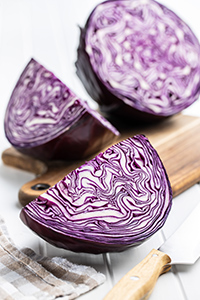
RED CABBAGE
Brassica oleracea L. var. capitata ssp. Rubra
French: Chou roug
Spanish: Col roja, lombarda
German: Rotkohl.
These are similar in shape to the white cabbage, but their leaves are deep violet due to their anthocyanin content. Red cabbage has a slightly sweeter flavor than other cabbages. From a nutritional point of view, this variety is the least rich in proteins, vitamins, and minerals. However, it compensates by adding a note of bright color to the dishes in which it is used.

KOHLRABI
Brassica oleracea L. var. gongylodes
French: Chou-rave
Spanish: Colinabo, colirrábano, col rábano, colrabi
German: Kohlrabi
This Central European variety of cabbage is characterized by the white or purple 20-cm bulb (in diameter) that forms at its base. The plant’s central leaves (the tenderest) and the bulbs are eaten. The bulb is tender, juicy, and may be grated raw in a salad or sliced and fried. Like other cabbages, Kohlrabi leaves are rich in vitamins and minerals. The most significant nutrients are magnesium and beta-carotene ( provitamin A).
SAVOY CABBAGE
Brassica oleracea L. var. sabauda/bullata
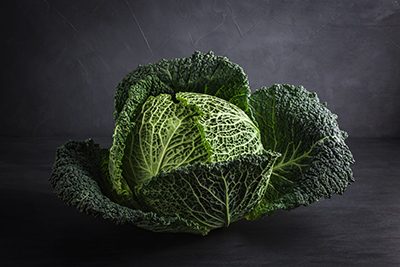
French: Chou cloqué, chou de Milan, chou de Savoie
Spanish: Col rizada, berza, col de Milán
German: Wirsing
The wrinkled leaves of the Savoy cabbage form a less compact head than other cabbages. The head may be rounded, oval, or pointed. The earliest crop appears in spring and has the lightest, most tender leaves. These are usually cooked in oil, steamed, or even eaten raw. On the other hand, the summer crop is intense green and has a more robust flavor. It is used in vegetable soups and stews. These are less nutritious than other varieties of cabbage.
Brassica oleraceae L. var. botrytis
Brassica oleraceae L. var. italica
Comparison of the Composition of Cabbages (per one hundred grams of raw edible portion)
| Proteins (grams) | Carbohydrates (grams) | Vitamin A (ug RE) | Folates (ug) | Vitamin C (mg) | Calcium (mg) | Iron (mg) | |
| Collard | 1.44 | 3.13 | 13 | 43 | 32.2 | 47 | 0.59 |
| Brussel sprouts | 3.38 | 5.16 | 88 | 61.1 | 85 | 42 | 1.4 |
| Savoy cabbage | 2 | 3 | 100 | 80.2 | 31 | 35 | 0.4 |
| Red cabbage | 1.39 | 4.12 | 4 | 20.7 | 57 | 51 | 0.49 |
| Kohlrabi | 1.7 | 2.6 | 4 | 16.1 | 62 | 24 | 0.4 |
| Chinese cabbage | 1.2 | 0.13 | 120 | 78.7 | 27 | 77 | 0.31 |
| Cauliflower | 1.98 | 2.7 | 2 | 57 | 46.4 | 22 | 0.44 |
| Broccoli | 2.98 | 2.24 | 154 | 71 | 93.2 | 48 | 0.88 |
From a botanical standpoint, a cabbage head is a spherical cluster of leaves. Most cabbages are heads, although some, such as cauliflower and broccoli, are inflorescences. White cabbage is also called a head cabbage.
To reduce the flatulent effect of cabbage, only the tenderest leaves should be chosen and then finely chopped, briefly cooked, and seasoned with lemon, oil, and anti-flatulent herbs (fennel), cumin, caraway, etc.). It must be chewed slowly, missing it well with saliva. It should not be eaten with other plant-based foods rich in cellulose fiber, such as whole grains or bran.
Experiments with laboratory animals confirm that regular consumption of the vast varieties of cabbages protects the body from the possible formation and development of tumors.
DISCLAIMER: All content on this website is presented solely for educational and informational objectives. Do not rely on the information provided as a replacement for advice, diagnosis, or treatment from a qualified medical expert. If you are pregnant, nursing, or have any preexisting medical concerns, talk to your doctor before using any herbal or natural medicines.
REFERENCES
- George D. Pamplona-Roger, M.D. “Encyclopedia of Foods and Their Healing Power.” George D. Pamplona-Roger, M.D. Encyclopedia of Foods and Their Healing Power. Trans. Annette Melgosa. Vol. 2. Chai Wan: Editorial Safeliz, 2005. 191, 192, 193, 194, 195, 196. Print. [health benefits of cabbage]
- Dietary fiber and body weight: https://www.ncbi.nlm.nih.gov/pmc/articles/PMC3892631/
- Vitamin C in dermatology: https://www.ncbi.nlm.nih.gov/pmc/articles/PMC5579659/
- https://fdc.nal.usda.gov/fdc-app.html#/food-details/169995/nutrients
